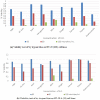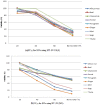Chemical Composition, Cytotoxic, Apoptotic and Antioxidant Activities of Main Commercial Essential Oils in Palestine: A Comparative Study
- PMID: 28930137
- PMCID: PMC5456243
- DOI: 10.3390/medicines3040027
Chemical Composition, Cytotoxic, Apoptotic and Antioxidant Activities of Main Commercial Essential Oils in Palestine: A Comparative Study
Abstract
Background: Essential oils (EOs) are complex mixtures of several components gifted with a wide array of biological activities. The present research was designed to evaluate whether commercial essential oils could be effective by examining their in vitro antioxidant, cytotoxic, and apoptotic properties of nine commercially available EOs in Palestine, namely, African rue, basil, chamomile, fennel, fenugreek, ginger, spearmint, sage, and thyme, and to assure their effective use. Methods: The cytotoxic activity was determined using HT29-19(A) non-muco secreting and HT29-muco secreting (MS) cell lines. MTT, and trypan blue tests, and DPPH radical scavenging have also been assayed on the studied EOs. Results: In this work chamomile oil showed the lowest IC50 at the content of 60 µL/mL, while all other EOs reached such a decrease when 70-80 µL/mL was used on HT-29 (MS) cell lines. In HT-29 19(A) cells, 50% of viability was obtained when 80 µL/mL of ginger and African rue was used, while all other EOs needed more than 80 µL/mL to reach such a decline in viability. Otherwise, an MTT assay on HT-29 (MS) displayed ginger EO with the lowest IC50, followed by African rue and sage, with 40, 48 and 53 µL/mL, respectively. Otherwise, for the rest of the EOs, the IC50 was obtained by assaying around 80 µL/mL. Ginger showed the lowest IC50 with 60 µL/mL and thyme was the highest with 77 µL/mL when HT-29 19(A) cells were used. Conclusion: The most active EOs were found to be ginger, chamomile oil, and African rue. In general, the results demonstrate that most commercial EOs tested in this work possess low, or no biological activities; this may be due to processing, storage conditions, and handling or other reasons, which may cause losses in the biological and pharmacological properties that endemically exist in the Eos; hence, more investigation is still required on commercial EOs before they are recommended to the public.
Keywords: anti-cancer activity; antioxidants; apoptosis; cell lines; cytotoxicity; essential oils (EOs).
Conflict of interest statement
The authors declare no conflict of interest.
Figures



Similar articles
-
In vitro antimicrobial and antioxidant activity of black thyme (Thymbra spicata L.) essential oils.Roum Arch Microbiol Immunol. 2012 Apr-Jun;71(2):61-9. Roum Arch Microbiol Immunol. 2012. PMID: 23210318
-
Chemical Composition and Antioxidant Properties of Essential Oils from Peppermint, Native Spearmint and Scotch Spearmint.Molecules. 2019 Aug 2;24(15):2825. doi: 10.3390/molecules24152825. Molecules. 2019. PMID: 31382468 Free PMC article.
-
Essential Oils from Fruit and Vegetables, Aromatic Herbs, and Spices: Composition, Antioxidant, and Antimicrobial Activities.Biology (Basel). 2021 Oct 25;10(11):1091. doi: 10.3390/biology10111091. Biology (Basel). 2021. PMID: 34827085 Free PMC article.
-
Essential Oils as Antimicrobial Agents-Myth or Real Alternative?Molecules. 2019 Jun 5;24(11):2130. doi: 10.3390/molecules24112130. Molecules. 2019. PMID: 31195752 Free PMC article. Review.
-
Therapeutic Effects of Essential Oils and Their Bioactive Compounds on Prostate Cancer Treatment.Pharmaceutics. 2024 Apr 24;16(5):583. doi: 10.3390/pharmaceutics16050583. Pharmaceutics. 2024. PMID: 38794244 Free PMC article. Review.
Cited by
-
Assessment of the Biological Activity of Thyme Essential Oil in the Presence of the Classic Antibiotic Tetracycline.Curr Health Sci J. 2022 Jan-Mar;48(1):18-23. doi: 10.12865/CHSJ.48.01.02. Epub 2022 Mar 31. Curr Health Sci J. 2022. PMID: 35911935 Free PMC article.
-
Medicinal Plants from Near East for Cancer Therapy.Front Pharmacol. 2018 Jan 31;9:56. doi: 10.3389/fphar.2018.00056. eCollection 2018. Front Pharmacol. 2018. PMID: 29445343 Free PMC article. Review.
-
Integration of medicinal plants into the traditional system of medicine for the treatment of cancer in Sokoto State, Nigeria.Heliyon. 2020 Sep 2;6(9):e04830. doi: 10.1016/j.heliyon.2020.e04830. eCollection 2020 Sep. Heliyon. 2020. PMID: 32939417 Free PMC article.
-
Chemometric Screening of Fourteen Essential Oils for Their Composition and Biological Properties.Molecules. 2020 Nov 4;25(21):5126. doi: 10.3390/molecules25215126. Molecules. 2020. PMID: 33158110 Free PMC article.
-
Does the World Need Plant Medicines?Medicines (Basel). 2018 Apr 23;5(2):39. doi: 10.3390/medicines5020039. Medicines (Basel). 2018. PMID: 29690579 Free PMC article. No abstract available.
References
-
- Alzeer B.J., Vummidi R., Arafeh R., Rimawi W., Saleem H., Luedtke N.W. The influence of extraction solvents on the anticancer activities of Palestinian medicinal plants. J. Med. Plants Res. 2014;8:408–415.
-
- Christaki E., Bonos E., Giannenas I., Florou-Paneri P. Aromatic Plants as a Source of Bioactive Compounds. Agriculture. 2012;2:228–243. doi: 10.3390/agriculture2030228. - DOI
-
- Bruneton J. Pharmacognosy, Phytochemistry, Medicinal Plants. Technique & Documentation; Lavoisier; Andover, France: 1999.
-
- Turek C., Stintzing F.C. Stability of Essential Oils: A Review. Compr. Rev. Food Sci. Food Saf. 2013;12:40–53. doi: 10.1111/1541-4337.12006. - DOI
LinkOut - more resources
Full Text Sources
Other Literature Sources

